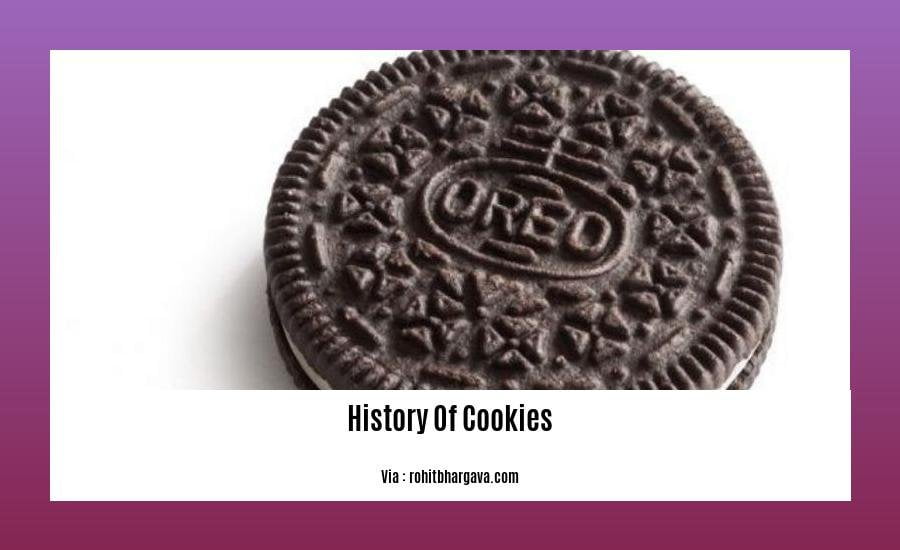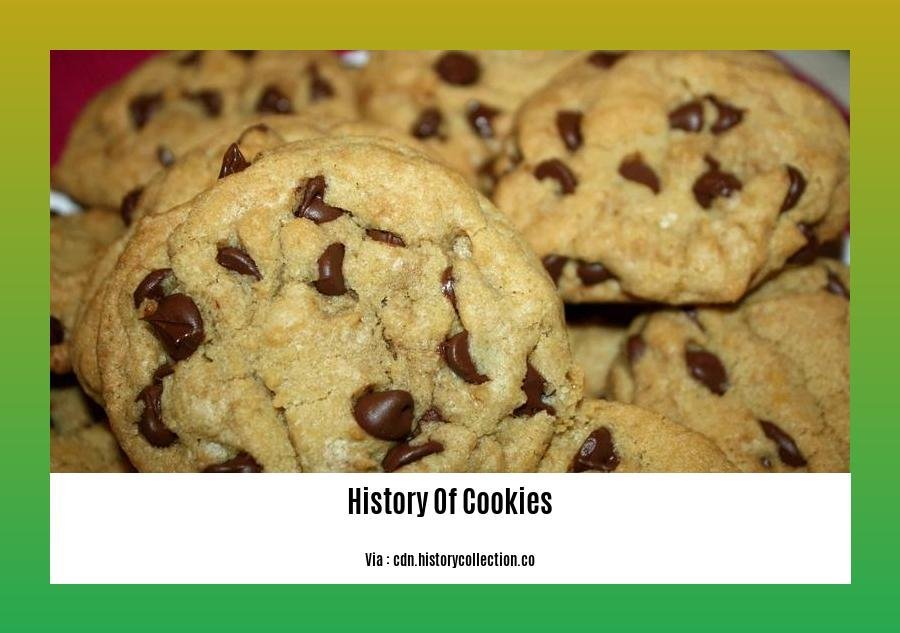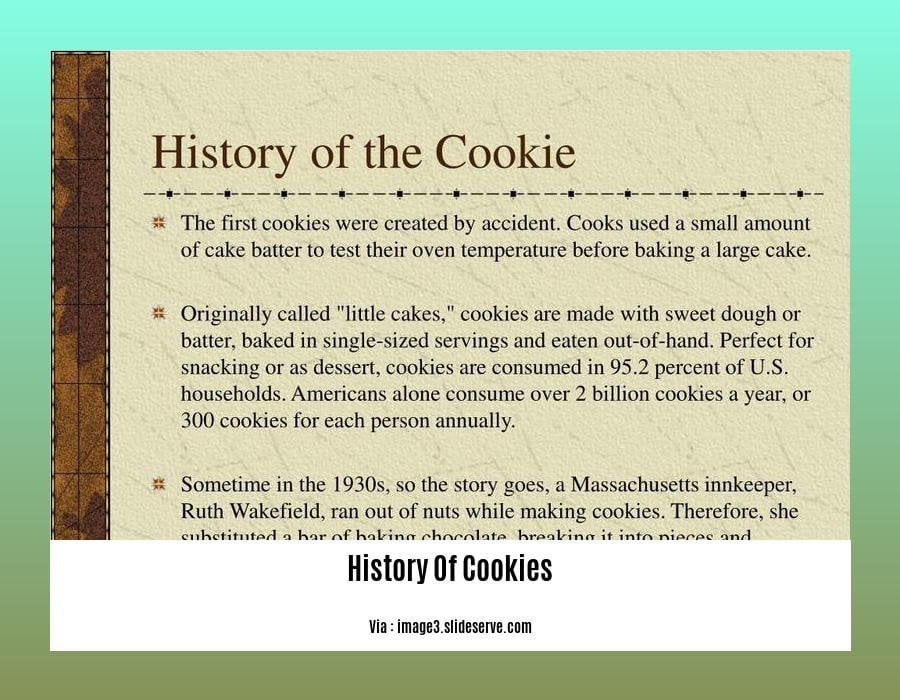Prepare your taste buds for a delectable journey through time as we explore the fascinating history of cookies in [A Sweet Journey Through Time: Unraveling the History of Cookies]. From their humble beginnings as ancient offerings to their transformation into the beloved treats we cherish today, cookies hold a captivating story that unfolds across cultures and centuries. Join us as we embark on this culinary adventure, tracing the evolution of these iconic confections and uncovering the secrets behind their enduring appeal.
Key Takeaways:
- Cookies originated in 7th-century Persia (modern-day Iran).
- Persia’s sugarcane cultivation contributed to cookie development.
- Cookies were initially used as test cakes for oven temperatures.
- Crusaders introduced cookies to Europe, bringing recipes with spices, fruits, and nuts.
- Renaissance cookbooks featured cookie recipes, including a popular square short-cookie in Elizabethan England.
**History of Cookies**

Prepare to embark on a culinary odyssey as we trace the history of cookies, a delectable treat that has tantalized taste buds for centuries. Join us as we explore the origins of these sweet delights, from their humble beginnings to their transformation into beloved global favorites.
🍪 The Birth of a Sweet Tradition
The journey of cookies begins in ancient Persia (present-day Iran), around the 7th century. This culinary innovation was born out of necessity, as bakers sought a way to test the temperature of their ovens. They created small, flat cakes that would bake quickly, acting as culinary thermometers.
🍪 A Sweet Treat Takes Flight
In the hands of adventurous Crusaders, cookies embarked on a global journey. These intrepid travelers brought their newfound love of cookies back to Europe during the Middle Ages, introducing a taste sensation that would soon captivate the continent.
🍪 Renaissance Refinement
The Renaissance witnessed a blossoming of cookie culture. Recipes began to appear in cookbooks, with one notable entry hailing from Elizabethan England. These square short-cookies, a testament to the era’s culinary prowess, laid the foundation for the diverse array of cookies we know today.
🍪 Cookies Across Cultures
As cookies journeyed across borders, they took on new forms and flavors, reflecting the diverse culinary traditions they encountered. In Germany, lebkuchen, a type of gingerbread, became a beloved holiday treat. The French introduced macarons, delicate almond-based confections that would become synonymous with their country’s pastry prowess.
🍪 Cookies Today: A Global Phenomenon
Today, cookies are a ubiquitous treat, enjoyed in every corner of the globe. From the classic chocolate chip cookie to the indulgent biscotti, these sweet delights have captured hearts and palates worldwide.
So, next time you savor the comforting crunch of a cookie, remember its rich history—a journey that began in ancient Persia and continues to evolve, one delicious bite at a time.
Discover the captivating history of cocoa, a delectable treat with a rich past that spans centuries.
Delve into the fascinating tale of cocoa beans, from their humble origins to their transformation into the beloved chocolate we cherish today.
Embark on a journey through the untold history of dragon fruit, a vibrant tropical fruit with a unique story to tell.
Renaissance Indulgence: Cookies as a Culinary Status Symbol

Cookie’s existence has been seasoned with indulgence and opulence since the Renaissance era. In the 16th century, sugar became more accessible due to the lucrative sugar trade routes. This sweet commodity found its way into the kitchens of affluent households, transforming cookies from humble treats into luxurious delicacies.
Sugar’s newfound prominence elevated cookies to a culinary status symbol. Wealthy families flaunted their extravagance by serving elaborate cookies at lavish banquets and gatherings. These cookies were often adorned with intricate designs and coated in layers of sugar glaze or icing, reflecting the host’s wealth and sophistication.
The artistry of cookie-making flourished during the Renaissance. Specialized cookie molds were meticulously carved with intricate patterns, imprinting exquisite designs onto the delicate dough. This attention to detail showcased the baker’s skill and creativity, further enhancing the cookie’s status as a culinary masterpiece.
During the Italian Renaissance, cookies took center stage in culinary innovations. Creative chefs experimented with a variety of spices, nuts, and dried fruits, creating cookies that tantalized the taste buds and showcased the region’s rich culinary heritage. These cookies became synonymous with Italian opulence and were often served as a grand finale to extravagant feasts.
The Renaissance Indulgence: Cookies as a Culinary Status Symbol extended beyond the confines of Italy. In France, lavish cookies known as “macarons” were created using almond flour and delicate layers of flavored filling. These cookies were exclusively enjoyed by the French aristocracy and were often served at royal banquets.
Throughout Europe, cookies became an integral part of courtly life. They were exchanged as gifts, served at celebrations, and featured in cookbooks that were passed down through generations.
Key Takeaways:
Cookies were transformed from simple treats into luxurious delicacies during the Renaissance due to the increased availability of sugar.
Elaborate cookies adorned with intricate designs and sugar coatings became a symbol of wealth and sophistication among affluent households.
The artistry of cookie-making flourished with the use of specialized molds, showcasing the baker’s skill and creativity.
Italy led culinary innovations in cookie-making, experimenting with spices, nuts, and dried fruits to create tantalizing flavors.
Cookies became an integral part of courtly life across Europe, exchanged as gifts, served at celebrations, and featured in cookbooks.
Sources:
- Delicious History: The Story of Cookies
- The History of Cookies and Biscuits
Global Exchange: Cookies Journey Across Continents
Who would have thought that these humble treats we know as cookies have traveled far and wide, weaving a tapestry of flavors and stories across continents? Let’s embark on this delectable journey and discover the Global Exchange: Cookies Journey Across Continents!
Origin of Sweetness
- Cookies trace their roots back to the 7th Century in Persia (modern-day Iran). [1]
- Sugarcane cultivation in Persia played a pivotal role in the development of cookies. [1]
- Through war and exploration, both sugar and cookies spread their sweetness across the world. [1]
A Name with History
- The word “cookie” itself has a fascinating history. [1]
- Dutch settlers brought their cookie recipes to America, and the name stuck. [1]
- While Americans use “cookie,” the British prefer “biscuit.” [1]
- Each name holds a unique story, reflecting the journey of these beloved treats.
Key Takeaways:
- Cookies originated in 7th Century Persia, where sugarcane cultivation played a crucial role in their development.
- The spread of sugar and cookies occurred through war and exploration, leading to their global presence.
- The term “cookie” originated from Dutch settlers who brought their recipes to America, while the British use the term “biscuit,” reflecting the diverse linguistic journey of these treats.
Sources
[1] GrabOn. (n.d.). Delicious History: The Story of Cookies. Retrieved from
[2] DoDo Cookie Dough & Ice Cream. (n.d.). A Brief History of the Cookie. Retrieved from
Modern Transformations: The Rise of Mass Production and Cultural Adaptations
The history of cookies is a testament to the enduring power of human ingenuity and adaptation. From their humble beginnings in ancient Persia to their global prominence today, cookies have undergone a fascinating journey, shaped by cultural influences, technological advancements, and the ever-evolving tastes of consumers.
The Rise of Mass Production:
Cookies’ transition from artisanal delights to mass-produced treats began with the Industrial Revolution. The invention of machinery, such as automated mixers and ovens, revolutionized cookie production, enabling the creation of large quantities with greater efficiency. This surge in productivity led to cookies becoming increasingly accessible and affordable, spreading their popularity beyond the confines of royal courts and wealthy households.
Cultural Adaptations:
As cookies spread across cultures, they encountered a kaleidoscope of culinary traditions and ingredients. This cross-pollination of flavors and techniques resulted in a myriad of unique variations adapted to local palates. For example, the French macaron, with its delicate almond meringue shells and vibrant fillings, is a testament to French culinary artistry. In Germany, lebkuchen, a spicy gingerbread cookie, reflects the country’s love for hearty flavors.
The impact of cultural adaptation on cookies is not limited to flavor profiles. In Japan, for instance, cookies took on a distinctly artistic dimension, becoming intricately decorated confections known as wagashi. These cookies are not just sweet treats but edible works of art, often adorned with seasonal motifs or auspicious symbols.
Modern Transformations:
In the modern era, cookies have undergone further transformations, driven by evolving consumer preferences and technological advancements. The rise of health consciousness has given birth to a new generation of cookies made with healthier ingredients, such as whole grains, nuts, and fruits. Gluten-free and vegan cookies have emerged to cater to specific dietary needs and ethical choices.
Technology has also played a significant role in the modernization of cookies. The internet has facilitated the sharing of cookie recipes and baking techniques, inspiring a global community of bakers to experiment with new flavors and designs. Social media platforms have become a virtual showcase for cookie creations, fueling trends and encouraging culinary creativity.
Key Takeaways:
Mass production: The Industrial Revolution ushered in an era of mechanized cookie production, making them more accessible and affordable.
Cultural adaptations: As cookies traveled the globe, they encountered diverse culinary traditions, leading to a myriad of unique variations adapted to local tastes.
Modern transformations: Contemporary cookies reflect evolving consumer preferences and technological advancements, with a focus on healthier ingredients, dietary inclusivity, and the sharing of recipes online.
Sources
- The History of Cookies: A Sweet Treat With a Rich Past
- The Evolution of Cookies: From Ancient Persia to Modern-Day Treats
FAQ
Q1: Where did cookies originate?
A1: Cookies originated in Persia (modern-day Iran) around the 7th century AD, where sugarcane cultivation contributed to their development.
Q2: How were cookies initially used?
A2: Initially, cookies were utilized as test cakes to determine the temperature of ovens before baking other items.
Q3: How did cookies spread to Europe?
A3: Cookies were introduced to Europe during the Middle Ages by returning Crusaders, who brought recipes incorporating spices, fruits, and nuts.
Q4: When did cookie recipes become popular in cookbooks?
A4: During the Renaissance, cookie recipes gained popularity in cooking books, with notable examples like the square short-cookie from Elizabethan England.
Q5: What is the significance of cookies in the history of baking?
A5: Cookies hold a significant place in baking history, as they represent the evolution of culinary practices from ancient rituals to beloved treats, reflecting the influence of cultural exchanges and innovations over time.
- SYBAU See You Baby Meaning: Gen Z Slang Evolves - July 1, 2025
- Unlock Your Inner Youth: Lifestyle Secrets for a Vibrant Life - July 1, 2025
- Decode SYBAU Meaning: Gen Z Slang Explained - July 1, 2025






